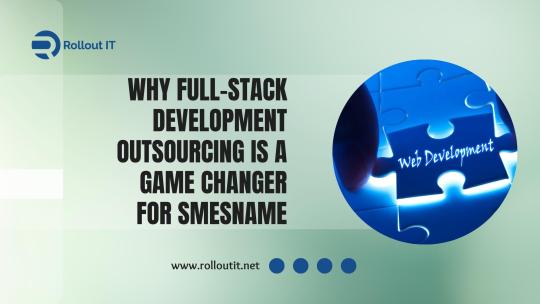#FullStackDevelopmentOutsourcing
Explore tagged Tumblr posts
Text
Why Full-Stack Development Outsourcing is a Game Changer for SMEs

In today's fast-paced digital landscape, small and medium-sized enterprises (SMEs) face the challenge of keeping up with technological advancements while managing limited resources. Full-stack development outsourcing has emerged as a game changer, providing SMEs with the expertise and flexibility needed to thrive. Here’s why outsourcing full-stack development can revolutionize your business.
Cost Efficiency
One of the primary benefits of full-stack development outsourcing is cost efficiency. Hiring in-house developers can be expensive due to salaries, benefits, and training costs. Outsourcing allows SMEs to access a pool of skilled professionals without the overhead expenses associated with full-time employees. This cost-saving enables SMEs to allocate resources to other critical areas, such as marketing and product development, fostering overall growth.
Access to Top Talent
Outsourcing full-stack development opens the door to a global talent pool. SMEs can leverage the expertise of seasoned developers from around the world, ensuring high-quality solutions and innovative approaches. This access to top-tier talent is particularly advantageous for SMEs that may struggle to attract and retain skilled developers locally. By partnering with an experienced outsourcing provider, businesses can tap into specialized skills and knowledge that drive competitive advantage.
Scalability and Flexibility
Full-stack development outsourcing offers unmatched scalability and flexibility. SMEs often experience fluctuating workloads, and outsourcing allows them to scale their development teams up or down based on project needs. This adaptability ensures that businesses can respond quickly to market changes and customer demands without the constraints of fixed staffing levels. Additionally, outsourcing providers can offer a range of services, from front-end development to back-end integration, tailored to the specific requirements of each project.
Focus on Core Competencies
By outsourcing full-stack development, SMEs can focus on their core competencies. Instead of diverting attention and resources to manage complex development tasks, businesses can concentrate on their primary operations and strategic goals. This focus enhances productivity and innovation, enabling SMEs to deliver better products and services to their customers. Furthermore, outsourcing development tasks can reduce time-to-market, giving SMEs a competitive edge in their industry.
1 note
·
View note
Text
Why Full-Stack Development Outsourcing Is a Smart Move for Modern Businesses

Outsourcing full-stack development has become a popular strategy for many companies looking to build robust web applications efficiently and cost-effectively. Managing remote teams, however, comes with its unique challenges. When done right, full-stack development outsourcing can boost your project’s success and deliver quality results on time.
If you are considering or already working with remote developers, especially through frontend development outsourcing or IT outsourcing in Hungary, this guide will help you manage your teams effectively.
1. Set Clear Goals and Expectations
One of the most important steps in managing remote teams is to establish clear goals. Your outsourced team should know exactly what is expected, including:
Project milestones and deadlines
Quality standards and coding guidelines
Communication frequency and tools
Clear instructions help avoid confusion and keep everyone aligned on the project vision.
2. Choose the Right Communication Tools
Good communication is the backbone of remote team management. Use reliable tools to stay connected and monitor progress. Some popular options include:
Slack or Microsoft Teams for instant messaging
Zoom or Google Meet for video calls
Jira or Trello for project management
Regular check-ins, such as daily standups or weekly updates, help maintain transparency and build trust between you and the remote developers.
3. Focus on Building Trust and Collaboration
Trust can be harder to build with remote teams since you don’t share a physical workspace. Encourage collaboration by:
Promoting an open culture where team members can share ideas and ask questions
Recognizing the efforts and achievements of your developers
Encouraging informal chats to create personal connections
When developers feel trusted and part of the team, they become more motivated and productive.
4. Understand Time Zone Differences
Many companies outsource development to countries like Hungary, which is known for strong IT talent and competitive costs. If you choose IT outsourcing in Hungary, be aware of time zone differences and plan meetings accordingly. Some tips include:
Scheduling overlapping working hours for real-time collaboration
Using asynchronous communication for tasks that don’t require immediate response
Being flexible with deadlines when needed
By respecting time zones, you ensure smoother workflows and reduce delays.
5. Define Roles and Responsibilities Clearly
In a full-stack development team, roles can range from frontend developers to backend engineers and testers. To avoid overlap and confusion:
Clearly define who handles what part of the project
Use documentation to outline responsibilities
Assign team leads to coordinate different sections of the project
This clarity helps improve efficiency and prevents tasks from falling through the cracks.
6. Monitor Progress Without Micromanaging
While it’s important to track the development process, avoid micromanaging your remote team. Use tools like GitHub, Bitbucket, or project dashboards to:
Review code commits and progress reports
Check completed tasks against milestones
Give constructive feedback regularly
Trust your team to manage their daily work while you focus on guiding and supporting them.
7. Provide Access to Necessary Resources
Make sure your remote developers have everything they need to succeed. This includes:
Access to design files, APIs, and development environments
Clear documentation on project requirements
Tools and software licenses needed for development
Providing proper resources helps reduce delays and technical roadblocks.
8. Encourage Continuous Learning and Improvement
Technology evolves quickly, especially in full-stack development. Encourage your team to:
Keep up with the latest frontend and backend technologies
Share knowledge within the team through workshops or code reviews
Adopt best practices in coding and testing
A learning-focused environment improves the quality of your project and keeps your team engaged.
Why Consider IT Outsourcing in Hungary?
Hungary has become a popular destination for frontend development outsourcing and full-stack development outsourcing due to its skilled workforce and favorable business environment. Many companies choose Hungary because:
The country has a strong technical education system
Developers are experienced in modern technologies
The location allows for easier collaboration with European time zones
If you are exploring outsourcing options, Hungary is definitely worth considering.
Conclusion
Managing remote teams for full-stack development doesn’t have to be complicated. By setting clear goals, using effective communication tools, building trust, and respecting cultural and time differences, you can create a productive and happy remote team.
Whether you are outsourcing frontend or backend work, or considering IT outsourcing in Hungary, following these steps will increase your chances of delivering a successful project on time and within budget.
0 notes
Text
How to Ensure Quality Control in Frontend Development Outsourcing

Outsourcing frontend development is a common practice for businesses looking to save costs and access skilled developers worldwide. However, one of the biggest concerns is ensuring the quality of the work. In this blog, we’ll share simple and effective ways to maintain quality control when outsourcing your frontend development.
1. Set Clear Expectations from the Beginning
The key to quality control starts right from the beginning. It’s essential to have clear expectations with your outsourcing partner about what the project should achieve, what it will include, and how it will be completed.
What you can do:
Define the Project: Create a clear project outline that explains what you want to be done. Be specific about the features, design, and functionality you expect.
Agree on Communication: Decide how often you’ll check in with the team and what tools will be used to share updates.
2. Choose the Right Partner
Choosing the right partner for Frontend Development Outsourcing is crucial for maintaining quality. You need a team with the right skills and experience for your project.
What to look for:
Experience: Find a partner who has a strong background in frontend development. They should be comfortable with modern technologies like React, Angular, or Vue.js.
Portfolio and Reviews: Check their previous work to see if they’ve done similar projects and if their past clients were happy with the results.
Time Zone Considerations: If you’re outsourcing internationally, such as with IT Outsourcing in Hungary, make sure their working hours overlap enough with yours for easy communication.
3. Set Up a Review and Feedback Process
Reviewing the work regularly is one of the best ways to ensure quality control. Don’t wait until the end of the project to see the result. Frequent checks help catch issues early on.
How to do it:
Regular Check-ins: Break the project into smaller milestones and review the work at each stage. This keeps the project on track and helps you spot any problems early.
Use Version Control: Tools like Git allow you to track changes in the code, making it easier to monitor progress and spot bugs.
Peer Reviews: Have the team check each other’s work. This improves the quality of the code and catches errors that might be missed by just one person.
4. Establish Clear Coding Standards
Good quality code is clean, readable, and easy to maintain. It’s important to set clear guidelines for coding practices that your outsourcing team should follow.
What you can do:
Code Style: Define a consistent coding style for your team. This includes rules about naming, indentation, and file structure. Tools like ESLint can help automate this.
Responsiveness: Ensure the website or app is responsive, meaning it looks good on all screen sizes.
Performance: Your team should also focus on performance optimization to make sure your site loads quickly and runs smoothly.
5. Test the Product Early and Often
Testing is an important part of quality control. The earlier you start testing, the easier it is to fix issues before they grow into bigger problems.
Types of testing to include:
Unit Testing: Test individual components of your website or app to make sure they function properly.
Integration Testing: Check that different parts of the site or app work well together.
User Testing: Test the product from a user’s perspective to ensure it works as expected.
Cross-Device Testing: Make sure the frontend works well on all devices, like phones, tablets, and desktops.
6. Maintain Ongoing Communication
Communication is key to successful Frontend Development Outsourcing. Keep in touch with your team regularly to discuss progress, address concerns, and give feedback.
How to communicate effectively:
Frequent Updates: Schedule regular meetings (daily or weekly) to check on progress and discuss any roadblocks.
Collaboration Tools: Use tools like Slack, Jira, or Trello to track tasks and communicate easily with your team.
7. Evaluate After Launch
Quality control doesn’t stop once the project is complete. After the frontend is live, it’s important to keep an eye on how it performs and fix any issues that arise.
What to do after launch:
Monitor User Feedback: Collect feedback from users to see if they face any issues or if there are any areas that could be improved.
Ongoing Maintenance: Make sure your team is available for any updates or bug fixes that might come up after the launch.
Conclusion
Ensuring quality in Frontend Development Outsourcing is a continuous process that starts with setting clear expectations, choosing the right partner, and maintaining communication throughout the project. By following best practices like regular reviews, clear coding standards, and consistent testing, you can ensure that your frontend development meets the highest standards.
If you are considering Full-Stack Development Outsourcing or IT Outsourcing in Hungary, these steps will help you manage quality control effectively and ensure a successful project. With the right approach, outsourcing your frontend development can be a highly productive and cost-effective solution for your business.
#FrontendDevelopmentOutsourcing#WebDevelopment#OutsourcingTips#FullStackDevelopmentOutsourcing#ITOutsourcing#RemoteDevelopment
0 notes
Text
Full-Stack Development Outsourcing – Boost Your Business Now

Maximize efficiency and reduce costs with full-stack development outsourcing. Our expert developers handle front-end, back-end, databases, and APIs to deliver seamless, high-performance solutions. Whether you need a web or mobile app, we provide scalable, secure, and customized development services. Boost your business now with reliable, cost-effective full-stack development outsourcing—quality solutions delivered on time!
0 notes
Text
Why Businesses Are Embracing Full-Stack Development Outsourcing in 2025

In 2025, businesses are increasingly turning to Full-Stack Development Outsourcing to streamline operations, reduce costs, and access top talent. With growing digital demands, companies need skilled developers who can handle both frontend and backend development. Outsourcing full-stack development has become a strategic move for many organizations, allowing them to stay competitive in a fast-changing technology landscape.
Benefits of Full-Stack Development Outsourcing
1. Access to Skilled Developers
Finding in-house full-stack developers with expertise in both frontend development outsourcing and backend technologies can be challenging. By outsourcing, businesses gain access to a global talent pool with specialized skills, ensuring high-quality development.
2. Cost Efficiency
Outsourcing full-stack development helps companies save on hiring, training, and infrastructure costs. Many businesses choose IT outsourcing in Hungary, where they can find highly skilled developers at competitive rates without compromising on quality.
3. Faster Project Delivery
Experienced full-stack development teams work efficiently, reducing project timelines. Since they handle both frontend and backend, there is better coordination, leading to faster deployment of software applications.
4. Focus on Core Business Functions
By outsourcing development tasks, companies can concentrate on their core business functions, such as marketing, sales, and customer service. This allows for better resource allocation and improved overall efficiency.
5. Scalability and Flexibility
Outsourced teams provide the flexibility to scale development efforts up or down based on business needs. Whether it’s launching a new product or upgrading an existing system, outsourcing allows businesses to adapt quickly.
Why IT Outsourcing in Hungary Is Gaining Popularity
Hungary has become a preferred destination for IT outsourcing in Hungary due to several factors:
Highly Skilled Developers: Hungary has a strong educational system producing talented IT professionals.
Cost-Effective Solutions: Businesses can access top-tier developers at lower costs compared to Western Europe and North America.
Time Zone Compatibility: Hungary's location makes it an excellent outsourcing choice for businesses in Europe and the US.
Strong IT Infrastructure: With a growing tech ecosystem, Hungary offers reliable and secure development services.
How Full-Stack Development Outsourcing Works
Identifying Business Needs – Companies assess their development requirements and decide on the scope of outsourcing.
Selecting the Right Partner – Choosing an experienced outsourcing provider with expertise in frontend development outsourcing and backend technologies is crucial.
Project Planning and Execution – The outsourced team collaborates with the business to create a roadmap and execute the project efficiently.
Continuous Communication and Monitoring – Regular updates and performance tracking ensure the project stays on course.
Delivery and Maintenance – After deployment, ongoing support and maintenance ensure smooth operation.
Future of Full-Stack Development Outsourcing
As businesses continue to digitize their operations, full-stack development outsourcing will remain a vital strategy. Emerging technologies like AI, cloud computing, and blockchain are driving demand for skilled developers, making outsourcing an effective solution for companies looking to stay ahead.
Conclusion
Outsourcing full-stack development in 2025 offers businesses access to skilled professionals, cost savings, and faster project completion. With increasing demand, destinations like IT outsourcing in Hungary are becoming popular for high-quality development services. Whether it's frontend development outsourcing or end-to-end full-stack solutions, outsourcing remains a smart choice for businesses aiming for growth and efficiency.
By leveraging full-stack development outsourcing, companies can focus on innovation and scale their digital initiatives seamlessly in the competitive tech landscape of 2025.
#FullStackDevelopmentOutsourcing#ITOutsourcing#ITOutsourcingHungary#FrontendDevelopmentOutsourcing#SoftwareDevelopment#OutsourcingBenefits#TechTrends2025
0 notes
Text
Is Full-Stack Development Outsourcing Right for Your Business?

Full-stack development outsourcing can be a game-changer for businesses looking to accelerate their digital projects while reducing costs. By partnering with expert developers, companies can access a wide range of skills, from front-end design to back-end functionality, without the need to hire and train an in-house team. This approach not only enhances efficiency but also provides flexibility to scale your tech resources as needed. Whether you’re a startup aiming to launch quickly or a growing enterprise in need of innovation, full-stack development outsourcing offers a cost-effective solution to achieve your goals and maintain a competitive edge.
0 notes
Text
Why Full-Stack Development Outsourcing is Revolutionizing Tech Projects

In today's rapidly evolving tech landscape, companies are increasingly turning to full-stack development outsourcing to meet their project demands. This approach, which involves hiring external experts to handle both front-end and back-end development, is revolutionizing the way tech projects are executed. By leveraging the expertise of full-stack developers, businesses can achieve faster project completion, cost savings, and access to cutting-edge technology, all while maintaining a focus on core competencies. Here's why full-stack development outsourcing is becoming a game-changer for tech projects.
Access to a Diverse Skill Set
Full-stack developers are proficient in both front-end and back-end technologies, making them versatile assets to any tech project. Outsourcing full-stack development allows companies to tap into a wide range of skills without the need to hire multiple specialists. This means that projects can be executed more efficiently, with a seamless integration of different components. Whether it's creating a user-friendly interface or ensuring robust server-side operations, full-stack development outsourcing provides the expertise needed to deliver high-quality solutions.
Accelerated Project Timelines
Time is a critical factor in the tech industry, where delays can lead to missed opportunities and increased costs. Full-stack development outsourcing enables companies to speed up their project timelines by utilizing skilled professionals who are experienced in managing complex tasks. With a dedicated team working on both ends of the development spectrum, businesses can expect faster turnaround times and quicker time-to-market, giving them a competitive edge.
Cost-Effective Solutions
Hiring and maintaining an in-house full-stack development team can be expensive, especially for startups and small businesses. Outsourcing provides a cost-effective alternative, allowing companies to access top-tier talent without the overhead costs associated with full-time employees. This not only reduces labor costs but also allows businesses to allocate resources more effectively, focusing on growth and innovation.
Staying Ahead with Cutting-Edge Technology
Technology is constantly evolving, and keeping up with the latest trends and tools can be challenging for in-house teams. Full-stack development outsourcing firms are often at the forefront of technological advancements, providing their clients with access to the latest tools, frameworks, and best practices. By outsourcing, businesses can stay ahead of the curve, ensuring that their tech projects are built using the most up-to-date and efficient technologies available.
Conclusion
Full-stack development outsourcing is revolutionizing the way tech projects are managed and executed. By offering access to a diverse skill set, accelerating project timelines, providing cost-effective solutions, and ensuring the use of cutting-edge technology, outsourcing has become a vital strategy for businesses looking to succeed in the fast-paced tech industry. As more companies recognize the benefits, full-stack development outsourcing is set to continue its rise as a preferred approach for tech project success.
0 notes